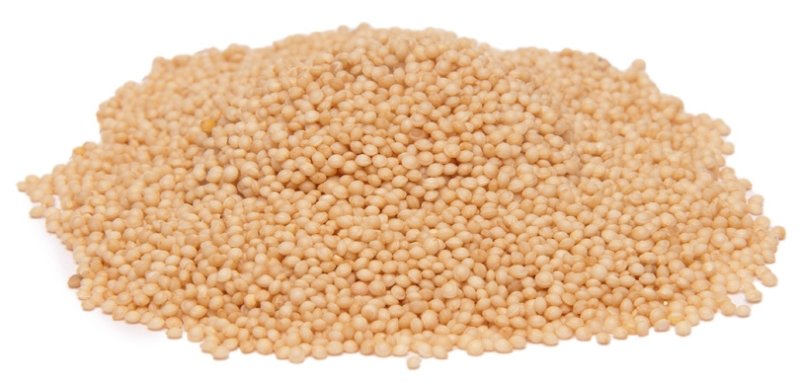Organic Amaranth
$6.49
Carousel Images
Organic Amaranth
Delivery Options
Overview
Shelf Life: Store in a cool dry place for up to 6 months. It is ok to refrigerate.
Origin: India
Product ID: 7507
Shelf Life: Store in a cool dry place for up to 6 months. It is ok to refrigerate.
Origin: India
Product ID: 7507
Organic amaranth is a sweet, earthy, gluten-free grain. It’s extremely high in protein, iron, and fiber, and is a staple in gluten-free diets. Amaranth is a versatile grain that can be enjoyed as part of a satisfying hot breakfast, in delectable cookies, in savory soups, and more!
How to Cook Amaranth
Use 1/2 cup amaranth to 1 1/2 cups water, broth, or liquid. To cook, combine amaranth and liquid in a pot, and bring to a boil. Reduce the heat to low and let it simmer uncovered for 20-25 minutes until all of the water is absorbed.
Amaranth Cooking Ideas
Amaranth is a gluten-free grain that offers versatility as well as flavor. There are many different methods to cook and eat organic amaranth, from cooking it like rice to popping it like popcorn!
A simple way to prepare amaranth is to boil it for about 15-20 minutes and add it to your morning cereal or toss it in a salad, similar to how you might eat couscous or quinoa.
You can also grind it into amaranth flour to use in baked goods, potentially toasting it to bring out more of its nutty flavor before your grind it.
A fun way to eat amaranth is to pop it and season it like popcorn.
Whole seed, cooked organic amaranth also goes well in soups, granolas, and bread.
Amaranth Grain Health Benefits
Amaranth is a Protein Powerhouse: Amaranth is made up of 13-14% protein, and it easily contains 30% more protein than other grains. Amaranth contains the important amino acid lysine, which is not found in many grains and is vital for building muscle protein and helping the body run.
Amaranth Contains More Fiber Than Any Other Gluten-Free Grain: One cup of amaranth contains 18g of fiber, more than any other gluten-free grain. In comparison, buckwheat and millet contain 17g and white rice contains 2.4g.
Amaranth May Lower LDL “Bad” Cholesterol Levels: Amaranth is one of the few grains that contain phytosterols, nutrients that play a major part in the prevention of many kinds of disease and may lower LDL cholesterol levels. University of Guelph researchers discovered that amaranth contains all three major phytosterols, which have cholesterol-lowering properties. These findings are published in the journal Plant Foods for Human Nutrition.
Amaranth Reduces Inflammation: A 2008 study published in the Journal of Agricultural and Food Chemistry identified the presence of bioactive peptides in amaranth, which are compounds that protect against inflammation associated with chronic conditions like diabetes, heart disease, and cancer.
Amaranth is a Rich Source of Vitamins and Minerals: Amaranth is loaded with essential vitamins and minerals to keep your immune system strong and support your body’s many functions. Amaranth boasts minerals like calcium, magnesium, zinc, potassium, and vitamins A, C, K, B5, B6, folate, and riboflavin.
Amaranth is Easy to Digest: Cooked amaranth is 90% digestible, making it easy on the digestive tract and also enabling your body to effectively use amaranth’s rich source of vitamins, minerals, and other nutrients.
Storage Tips
It is best to store organic amaranth in a tightly sealed container, preferably a glass jar, in a cool, dark, dry location. Do not store organic amaranth in a cabinet near a stove, oven or dishwasher. If stored properly, organic amaranth can have a shelf life of up to one year.
Amaranth in Space
In 1985, Amaranth literally took off! This grain took a ride out of the Earth’s atmosphere on US Space Shuttle Atlantis’ maiden voyage. Astronauts conducted tests growing amaranth on space and ate amaranth cookies during their mission.
Amaranth in History
Amaranth was the favored grain of the Aztec empire where it was also used in religious ceremonies. The Aztecs would use amaranth to build statues of their religious deities, such as their hummingbird god. At the end of the celebrations, the statue would be broken down and eaten. Hoping to discourage Aztec religious practices, the Spanish conquistadors banned the cultivation of amaranth and it grew only as a weed for hundreds of years. Amaranth grain was re-discovered in the 1970s and its popularity resurged because of the grain’s high nutritional content.
Ingredients:
Organic Amaranth. Packaged in the same facility as: Peanuts, Tree Nut, Wheat, Soy, Milk, Sesame, Fish, Shellfish, Egg, and Sulfites.
Nutrition Facts
Serving size 28g (~1 oz.)
| Amount per serving | ||
|---|---|---|
| Calories | 104 | |
| % Daily Value | ||
Total Fat 2g | 3% | |
Saturated Fat 1g | 3% | |
Cholesterol 0mg | 0% | |
Sodium 1mg | 0% | |
Total Carbohydrate 18g | 6% | |
Dietary Fiber 2g | 8% | |
Total Sugars 1g | ||
Protein 4g | ||
Calcium | 3% | |
Iron | 12% | |
Potassium | 0% | |
The % Daily Value (DV) tells you how much a nutrient in a serving of food contributes to a daily diet. 2,000 calories a day is used for general nutrition advice
Click here to related CA Prop 65 Warning
Customer Reviews
– September 22, 2019
Teresa, Swampscott, Massachusetts
Verified purchaser
Best amaranth I have ever purchased. Delicious buttery, creamy and flavorful. Nuts.com always sends very fresh grains and beans. Quick delivery. Love all of Nuts.com organic products.
Featured Review
5 people found this review helpful
Size: 5lb bag
– 3 weeks ago
Jackie, La Crosse, Wisconsin
Verified purchaser
Haven't tasted it yet, but so happy that you have it offered.
Size: 1lb bag
Showing 2 of 94 reviews















